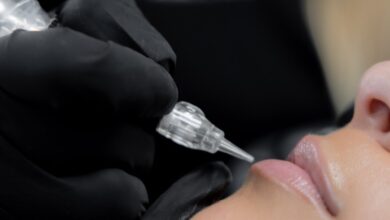Complete Guide To Laser Tattoo Removal — Before You Book

Getting a tattoo often feels like a statement, a memory, or even an art piece — much like a bold fashion choice that reflects your personality. But as time moves on, priorities shift, styles change, or regret creeps in. That means you either need to remove your tattoo or you just want to refresh your look for a new chapter. Making such a decision to eliminate ink is deeply personal; likewise, the approach chosen is of vital importance, especially if you value aesthetics and presentation.
Due to advancements in technology, laser-based treatments have become the preferred mode for the removal of unwanted tattoos. If you are in or near a major centre such as London and you are considering your options, it is worth understanding how the process works and what factors affect outcomes, costs, risks, and recovery. This guide will walk you through what to expect before considering laser tattoo removal, especially if you want your skin to look as fresh and flawless as your fashion choices.
1. Understand How the Technology Works
Laser tattoo removal has become the gold standard for the safe and efficient erasure of tattoos. These lasers emit short, high-intensity pulses of light that target the ink particles embedded in your skin. These pulses break the ink into smaller fragments, which then get flushed away by your body’s immune system. Notably, laser tattoo removal is far safer than older methods, such as dermabrasion or surgical excision, because the machine is calibrated to target pigment, thereby minimizing damage to surrounding skin. In most cases, you’ll find clinics and technicians that offer patch-testing along with personalized plans to better prepare you for what to expect and how to maximize your results. For those in the beauty and fashion world, clear skin often serves as a fresh canvas — a perfect base for your evolving sense of style or a new aesthetic direction.
2. How Many Sessions Will You Need and What Influences the Process?
One of the biggest questions is: “How many treatments will it take?” The answer varies because many factors come into play. All of it makes a difference: the size of the tattoo, how long you’ve had it, the color and type of ink, the depth of the tattoo in your skin, your skin tone, and how your immune system responds. Smaller, black-ink tattoos are usually the easiest to remove in fewer sessions; large, multicoloured tattoos on the extremities tend to be more difficult. Most clinics will recommend six to twelve sessions, several weeks apart, to allow the skin time to heal and your body time to process the ink fragments. The key here is to have realistic expectations: total disappearance cannot be guaranteed for every tattoo; however, significant fading usually can. Think of it as a gradual transformation — much like reinventing your wardrobe over time to match your current style.
3. Costs and Value Consideration

The cost of tattoo removal can vary greatly. It depends on the size of the tattoo, the ink colors (some, like green and yellow, are more stubborn), and the number of sessions required. Clinics might charge per session and sometimes offer packages for several sessions. It’s best to think about this as an investment in your skin and overall appearance. While cheaper alternatives may be available, they often use outdated technology or lack experience — which could mean more sessions, slower results, or a higher risk of side effects. True value lies not just in price but in outcome, comfort, and long-term satisfaction. Just as you wouldn’t compromise on the quality of fabric in fashion, the same applies to the care you choose for your skin.
4. Risk, Discomfort, and Recovery — What to Expect
Laser tattoo removal is much gentler than most older methods, but that doesn’t mean it’s entirely sensation-free or downtime-free. Many describe the feeling as similar to a quick, snapping sensation against the skin — mildly uncomfortable but tolerable. Afterward, you may experience some redness, swelling, or scabbing at the treatment site. You’ll be advised to keep it clean, avoid direct sunlight, and skip strenuous activity or hot baths for a few days. Though risks such as pigmentation changes or minor scarring exist, they are rare when a qualified specialist performs the treatment. Proper aftercare and realistic expectations help ensure smooth results. For those mindful of their appearance — whether in beauty, fashion, or lifestyle — proper healing ensures your skin stays photo-ready and radiant.
5. What to Ask During Your Consultation
A thorough consultation before booking gives you more clarity and confidence. Among the important questions to ask are: Is a patch test necessary? What laser technology are you using, and is it appropriate for my skin type and ink color? What results can I expect and in what timeline? Do you have before-and-after images of similar cases? What is the total cost and payment schedule? What aftercare will be required? What happens if some pigment is particularly stubborn? A good practitioner will provide honest assessments and avoid overpromising. That first visit sets the tone for your journey — much like the first fitting with a trusted stylist.
6. Aftercare and How to Maximize Your Results
Leaving the clinic doesn’t mean you’re done. It takes time — and the right conditions — for your body to absorb the ink particles between sessions and heal properly. Good aftercare is key to achieving smooth, glowing results. You should protect the treated area from the sun with SPF, avoid tanning beds, follow cleaning and ointment instructions carefully, skip hot tubs or heavy workouts for a few days, stay hydrated, and support your immune system, as it plays a vital role in breaking down ink particles. Regular sessions and proper rest between treatments will help ensure the skin recovers evenly and beautifully — much like caring for a delicate fabric between wears.
7. Setting Realistic Expectations — What Can and Can’t Be Achieved
It’s important to manage expectations. Many tattoos fade significantly or disappear completely after treatment, especially black or dark inks. However, some colors, older tattoos, and designs on sun-damaged or scarred skin may never completely vanish. Some faint “ghosts” or traces might remain — a reminder of your past aesthetic choices. That’s perfectly fine; style and self-expression evolve, and so does the skin that carries them.
Wrapping Up
Deciding to remove a tattoo is more than just an aesthetic decision — it’s about embracing change. Maybe you’re entering a new chapter, refreshing your style, or simply seeking a cleaner, more refined look. With proper preparation, realistic expectations, and expert guidance, the process becomes manageable and empowering. Understanding the technology, asking the right questions, and caring for your skin afterward will help you achieve results that align beautifully with your personal and fashion goals. Laser tattoo removal, in essence, isn’t just about erasing the past — it’s about making room for what’s next in your journey of style and self-expression.



